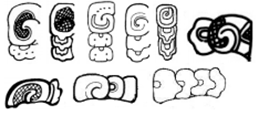![]()

![]()
![]()
![]()
K&H.p85.#6 K&L.p19.#2 [JM.p191.#4 = K&L.p19.#2.7] TOK.p8.r1.c6 BMM9.p19.r1.c1 JM.p191.#3 = 25EMC.pdfp44.#1.1
[JM.p191.#5 = K&L.p38.#8.1]
OCH OCH OCH OCH OCH OCH OCH
![]()

![]()
![]()
JM.p193.#2 MHD.ACDa.1&2&3 MHD.ACDb MHD.ACE.1&2
OCH:chi OOCH O’CH TZAB?

![]()

K&L.p38.#8.1&2 = 25EMC.pdfp44.#1.4&5 TOK.p9.r4.c2 25EMC.pdfp44.#1.2&3
OCH OCH OCH
![]()
![]()
![]()
![]()
![]()
K&L.p43.#5.1 K&L.p43.#5.2 TOK.p20.r1.c1 BMM9.p16.r2.c4 25EMC.pdfp44.#1.6 = JM.p192.#1
OCH OCH OCH OCH OCH OCH
![]()
![]()
K&L.p43.#5.3 25EMC.pdfp44.#1.7
OCH OCH
· No glyphs given in K&H for the hand-variant of OCH.
· K&L.p43.#5 indicates that the hand-variant occurs in ochk’in but its independent meaning is unknown. In other words, it’s used to write the sounds for och. For example in ochk’in, where the whole word does mean “enter sun” = “West”, but the glyph itself does not mean “enter” and is used solely for its sound value, i.e. as a rebus.
· Dorota Bojkowska: the hand-variant isn’t used as a general word for “enter” – for OCH = “enter”, the rattle-snake tail is used (see OCH-BIH).
· Variants (3):
o A. Rattlesnake rattle only – features:
§ 2 to 3 rattles, with, optionally, an initial element containing a spiral with protector:
· Can be horizontal or vertical.
· The spiral with protector is not part of the rattle, but probably the last segment on the rattlesnake, which seems to be always black. This has nothing to do with an infixed yi.
§ Optionally, a cross-hatched area in the uppermost element (the element containing a spiral/scroll – the one which is not the rattles).
o B. The tail-end of the snake, the head has already gone inside.
§ The end part of the body is visible, with (perhaps) a rattle at the end.
§ If it is a rattle, then it is much reduced in detail, compared to the variant which shows only the rattle itself. In this case, it resembles a roundish leaf with a sharp tip, with (optionally) a dotted spine.
o C. A closed hand, with the thumb pointing upwards:
§ Used only as a rebus.
§ While the hand mostly holds an object (perhaps a rock or some other weapon), there are sub-variants without an object (e.g. K&L.p43.#5.3).
· Caution - MHD distinguishes ACD from ACE:
o ACDa:transliterated as OOCH; 125 hits in “Classic - Blocks”, with the meaning “to enter”.
o ACDb: transliterated as O’CH; 5 hits in “Codical - Blocks”, with the meaning “to be fed” (passive verb).
o ACE: transliterated as TZAB?; 18 hits in “Classic - Blocks”.
Only ADCa corresponds to the familiar “enter” verb.

AT-E1168-lecture6.t0:07:30(.17)
o:chi